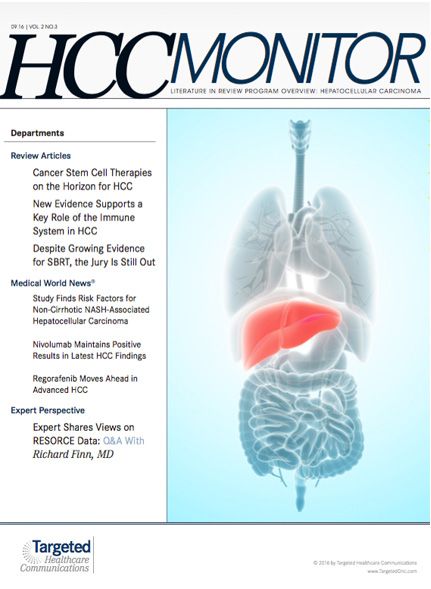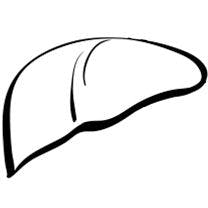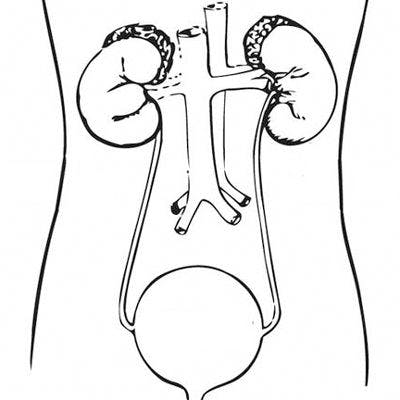Regorafenib Moves Ahead in Advanced HCC
After 9 years of failed trials for once-promising drugs, regorafenib (Stivarga) has emerged as the clear choice for second-line therapy in advanced hepatocellular carcinoma (HCC) after demonstrating survival improvements for patients whose disease has progressed after systemic treatment, according to liver cancer experts.
Regorafenib’s success is set against a background of continued development of novel agents that may widen the treatment options for patients with advanced disease in the near future, speakers reported at the 10th International Liver Cancer Association (ILCA) Annual Conference.
The near-term potential includes a head-to-head comparison between lenvatinib (Lenvima) and sorafenib (Nexavar) in a first-line setting, and separate phase III studies versus placebo of cabozantinib (Cabometyx; Cometriq) and tivantinib in second-line settings, noted Ann-Lii Cheng, MD, PhD.
He also pointed to phase III trials of 2 PD-1 inhibitors, nivolumab (Opdivo) and pembrolizumab (Keytruda), as possible practice-changers in the next several years. Nivolumab is being tested against sorafenib in patients with advanced HCC who have not received systemic therapy, while pembrolizumab is being compared with placebo in previously treated patients.
Jordi Bruix, MD, PhD, a professor of Medicine at the University of Barcelona and director of the Barcelona Clinic Liver Cancer (BCLC) Group, which he founded, joined Cheng, of the National Taiwan University College of Medicine, on the podium in the discussion of the advanced disease paradigm. Bruix was the lead investigator for the pivotal RESORCE trial on regorafenib.
Both Cheng and Bruix noted that research changes are needed for improved outcomes in HCC. Cheng emphasized that biomarkers, particularly an immune signature, must be identified to help guide therapy while Bruix stressed the importance of revising the standards by which tumor progression is judged.
Key Clinical Trial Findings
As it stands now, sorafenib is the only choice of systemic therapy for patients with advanced-stage HCC. Bruix said sorafenib is most effective for patients with stage C disease with symptoms including portal invasion and extrahepatic spread and Child-Pugh A-B scores, according to the BCLC algorithmthe most widely used staging system in the field.
The FDA approved sorafenib in 2007 for the treatment of patients with advanced, unresectable HCC based on a 3-month improvement in median overall survival (OS) compared with placebo (10.7 months vs 7.9 months; HR, 0.69).
Since then, phase III clinical trials have failed to register statistically significant improvements in OS in 5 first-line and 3 second-line studies involving targeted agents and, in 1 instance, chemotherapy regimens, according to Bruix.
That string of disappointments was broken earlier this year when Bruix and colleagues reported that regorafenib, which inhibits VEGF and multiple other kinases, improved median OS by 2.8 months versus placebo in the second-line setting.1Bayer Pharmaceuticals submitted the RESORCE findings to the FDA and the European Medicines Agency for approval.
In the RESORCE trial, patients who received regorafenib (n = 379) achieved a median OS of 10.6 months compared with 7.8 months for participants (n = 194) who received placebo (HR, 0.63; 95% CI, 0.50-0.79; 2-sidedP<.001).
Progression-free survival was 3.1 months with regorafenib compared with 1.5 months for placebo (HR, 0.46; 95% CI, 0.37-0.56; 2-sidedP<.001). Similarly, the time to progression (TTP) was 3.2 months for regorafenib compared with 1.5 months for placebo (HR, 0.44; 95% CI, 0.36-0.55; 2-sidedP<.001).
Bruix noted, however, that some of the agents that faltered in prior trials showed improvements in TTP or disease control rates that did not translate into an advantage in OS. He said shifting guidelines for evaluating changes in tumor sizes has beset the HCC field and sites at a greater frequency than have definitions for other solid tumor types.
Instead, he said progression should be evaluated in HCC based upon patterns of progression. BCLC researchers correlated progression in imaging and survival among patients treated among 147 patients treated with sorafenib and identified 3 patterns of progression: growth in intrahepatic or new intrahepatic tumor, growth of extrahepatic lesion, and new extrahepatic or vascular invasion.2
Immunotherapy Outlook
When it comes to immunotherapies under study, Bruix said in his presentation summary that “major hope has been placed in the benefits of immune treatment but data are still preliminary, and the optimistic feelings raised by the impact in other cancer types has to be validated in liver cancer.”
Cheng said there are so many emerging immunotherapy agents to explore that testing combinations likely to succeed in HCC is challenging. “Even with antiPD-1 as a backbone, we have 9 or 10 categories of drugs that could be combined and, in each category, we have many, many drugs.”
As a result, immune subtyping will be an important facet of advancing immunotherapy. “In the future, we will have to identify immune signatures in the microenvironment and that is an even tougher question,” said Cheng. “There are spatial and temporal dynamic changes of the immune microenvironment so any attempt to try to use only a single biopsy to identify an immune signature may not be possible, at least in the near future.”
References:
- Bruix J, Merle P, Granito A, et al. Efficacy and safety of regorafenib versus placebo in patients with hepatocellular carcinoma (HCC) progressing on sorafenib: results of the international, randomized phase 3 RESORCE trial. Presented at: 2016 World Congress on GI Cancer; June 28 - July 2, 2016; Barcelona, Spain. Abstracts LBA03.
- 1. Reig M, Rimola J, Torres F, et al. Postprogression survival of patients with advanced hepatocellular carcinoma: rationale for second-line trial design. Hepatology. 2013;58(6):2023-2031.

Survivorship Care Promotes Evidence-Based Approaches for Quality of Life and Beyond
March 21st 2025Frank J. Penedo, PhD, explains the challenges of survivorship care for patients with cancer and how he implements programs to support patients’ emotional, physical, and practical needs.
Read More






